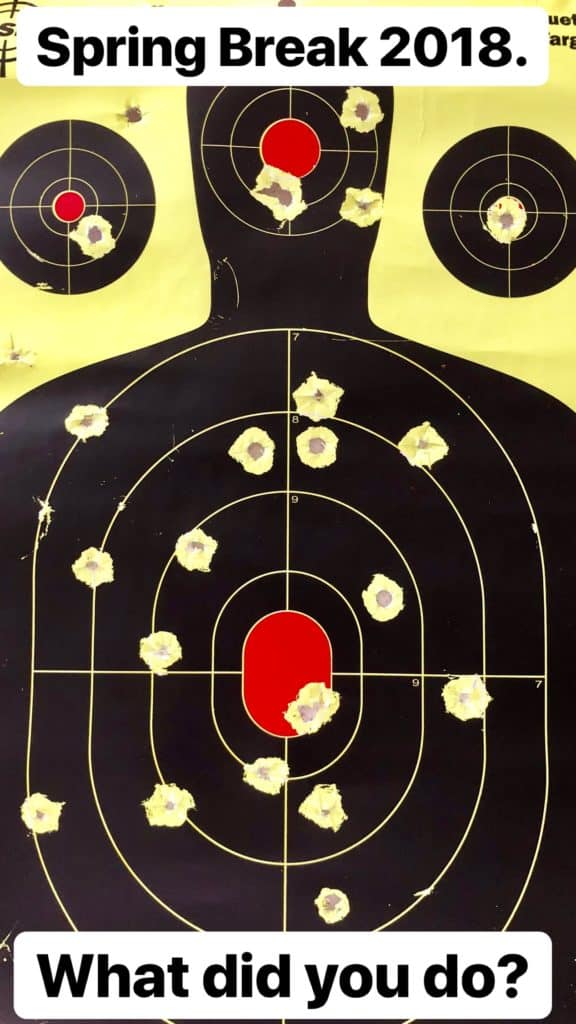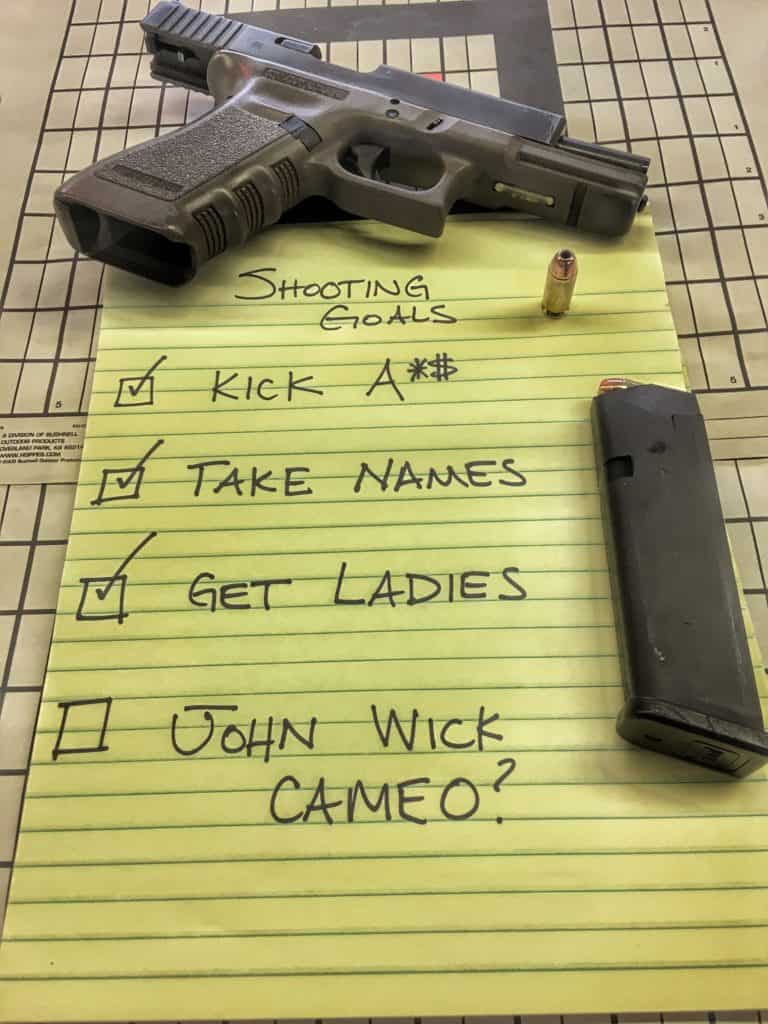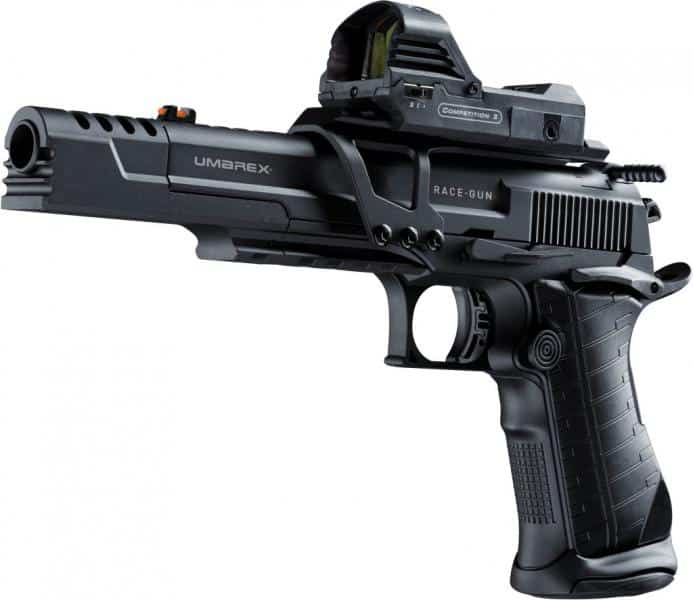Shooting Goals
“If I could do it all over again, I would do it right from the beginning…”
If I had a dollar for every time I’ve heard that phrase…
From work, to relationships, to financial issues, to even shooting and guns, that’s a very common sentiment. The feeling of “if I only knew then what I know now, wow I could’ve done stuff different from the beginning.”
As a new shooter, you have the RARE chance to get it right from the beginning. To do the little things that so few people do to get yourself on the right path from day 1. Taking small steps like setting your goals before you begin will immediately put you in rarefied air when compared to your shooting peers.
It’s not the most glamorous or fun side of shooting (we’re getting there), but taking a couple minutes now will pay dividends down the road and you need to get this sorted out first so the fun can begin.
It’s like I tell any student that gets frustrated trying to nail the fundamentals. “The effort to do it correct now pales in comparison to the effort it will take to undo a litany of bad habits later.”
At CFI I train all of my students that it’s the little things that you have to do to set yourself apart from the rest. It sounds like a cliché, it probably is, and it’s 100% correct.
(Almost) anyone can go out, buy a gun, put a few rounds down-range at some paper on the weekends now and then, and call it a day.
Blindly starting out and learning on your own as you go can be a painfully slow process. One that’s hopefully pointed in the right general direction if you’re lucky. It’s very easy to waste time and money along the way, follow poor advice, develop bad habits and lengthen the road between you and your shooting goals.

The BEST example of a “little thing” you can do to begin building a solid foundation that will set you apart is:
Taking the time to figure out your shooting goals.
This exercise, which will reveal answers that will save you countless hours and dollars, will take you a matter of minutes. Trust me.
Let me pause for a little story about someone who chose not to take the time to examine his goals. He ended up wasting almost $2,000 and a year of his time shooting before he got it right. We will call him Gus.
Gus’ buddies invited him shooting one weekend. He wasn’t a “gun guy” but he went anyway. Gus shot and found out that, to his surprise, he really enjoyed it. He wanted to see what more there could be to this “gun-thing.”
He talked to his friend who told him the only good reason to have a gun was to keep it on you at all times (concealed carry/personal carry). Gus took his advice, and in a few weeks, had invested $750 on a gun that would be perfect for concealed carry without trying it out, bought a holster for $65, spent $150 on his Concealed Carry course and was ready to go. Gus passed his class, but he wasn’t happy with the way his gun shot. He got some training to the tune of $200. He improved, but not by much.
Frustrated, Gus blamed his gun and decided he would buy another one; a nicer one. He invested another $1,000 this time. More money meant it would surely work better for him right?
It didn’t.
He spent another $100 on additional training and became passably proficient with his gun that he didn’t enjoy shooting.
He could not stand carrying this obnoxious hunk of metal around all day. It dug into his side, made it hard to go to the bathroom, and bumped into the car door when he got in or out. “BUT I GOT THE SMALL CONCEALABLE ONE” he grumbled . Gus had to remember where he could and could not carry his gun without breaking the law. Even traveling became an issue; driving to work brought him through Maryland where his concealed carry permit was absolutely useless.
Be sure to check NRA ILA’s State Gun Law Page for information about your state’s gun laws (including concealed carry, how to buy different firearms, etc.)
Gus finally realized he never wanted the hassle of concealed carry, all he really wanted was something to keep in the house for protecting his home. Something his wife could shoot well and he could have fun shooting with his friends. Having a good gun in his house would be plenty.
He traded in both of his concealed carry firearms that he hated (at a significant loss) and he didn’t even want to think about how much he had spent on ammunition and training so far.
After taking some time to think about why he actually wanted the gun, consulting some of the guys and gals at the local gun shop, he settled on a full-size .45 that lives on his nightstand. He took courses for basic marksmanship and defensive shooting and shoots his new gun incredibly well. He has fun at the range and has a gun that serves the purpose he needs it to serve.
Gus could have saved himself tons of time and money if he had just taken the time to figure out why he wanted the gun before he began spending and shooting. The moral of the story here? Simple.
Prior planning prevents poor performance (and saves you a ton of money and time.)
You can usually boil down the reasons people want to start shooting into four categories, or goals. Some can be a bit broad, others, very narrow. You may find that you begin in one and move along into another. It’s possible you fit into more than one and that is fine.

The point of this post is to make sure you take the few minutes to figure out where you land now, ahead of time, so you don’t wind up wasting so much time, effort, and money later.
So, what are the four basic categories of shooting you should consider? The goals you need to evaluate before you begin making choices?
- The “Weekend Target” / “Just Because” Shooter.
- Home Protection
- Concealed Carry (on-person protection)
- Competitive Shooting
As long as you are a good person following the law, there is no particular goal that is better than another.
You’ll notice big differences in each “goal” when it comes to 3 main categories:
Cost – How much money you will need to spend to achieve your goals. What kind of guns will you need? What will ammunition run you? How much time will you need to spend on the range? How much training will you need? What kind of extra gear is appropriate for you?
Training – You can find training on everything from basic safety, to marksmanship, to self defense, to legal issues, and more. Which will be right for you? Everyone does not need every kind of training. Your goals will ultimately dictate where you need to allocate your time and money to make sure you get the most out of shooting based on your goals.
Tools – While this is covered a bit in cost, it is assuredly its own category. You do not want to defend your home with a .22. If your only goal is to have fun on the weekends, you are wasting massive amounts of money on that .50 caliber desert eagle. Oh, and good luck carrying that s&w 686 6” barrel concealed during the summer time. (If some of those examples don’t make sense to you, that’s not a problem at all. Stay with us and they will.)
So there you have it. Let’s take a look at the 4 basic “goal buckets” you may fall into.
This is a basic primer on each, the goal here isn’t to dive deep into the differences, but to get you thinking honestly about where you fall, and give you a preview of what is to come with each.
Goal 1. The “Just Because”’ shooter.
Maybe you and your significant other don’t feel like going to the movies every week for date night and want to try something new. Maybe you just want to exercise your second amendment right and have some fun doing it. Perhaps you and your buddies need something to do for your birthday and thought “that’s some man-stuff to do right there” and you wound up liking the sport.
Whatever your reason behind it is, you’re more of a weekend plinker than a full-time “Rambo-type”.

To you shooting is a sport first and foremost. You have fun target shooting and when you get home the gun goes back in the safe until you’re ready to head out to the range again. You don’t need to spend hundreds of dollars on a vented, full sized .45 caliber 1911 handgun with a flared magazine well, a match barrel, and legal training about the use of deadly force. Good on you if you’d like to do all that, but to have fun and be safe in this first category you’ll only need:
- A basic gun. Stay tuned for videos and posts all about what this means. (What type of gun is right for you, etc.)
- A class in basic marksmanship and gun safety.
- Ear and eye protection
- Knowledge of your local laws to ensure that you are legally purchasing your gun, storing it properly and safely, and lawfully transporting your firearm when you’re going to and from the range.
For the weekend shooter that should have you about covered.
Goal 2. The “Home Protection” Shooter.
You’ve taken things a step beyond the “just because” shooter. You like your time on the range, but the reason you bought the gun was about more than putting holes in paper. Having a firearm in the home for the protection of you and yours is your ultimate goal. You have every reason to spend a bit more money on a larger caliber handgun for the home. The constricting size restraints of having to carry your gun around with you hidden all day don’t apply to you, that’s not why you got the gun in the first place. Perhaps you don’t live in a part of the country that allows you to carry concealed. Maybe You simply don’t feel the need to have a gun with you at all times, but want to know that your home and your family is secure. You will need:
- Basic safety and marksmanship training
- Legal training based on your state and local firearms and self-defense laws
- Advanced self-defense / firearms training
- Defense ammunition (hollow-point) for loading in your firearm when in the home
- Handgun chambered in .380 or larger
- More ammunition. You’re no longer practicing for a sport, you’re building a skill to protect yourself and the ones you love. You will need to train much more often with a laser focus on the fundamentals of defensive firearms shooting. This requires much more ammunition. You will do well to invest the time in finding a lower-cost bulk purchase platform like www.luckygunner.com to buy ammunition in bulk at a lower rate.
Goal 3. The “Personal Carry” Shooter.

You want a firearm for the same reason as the “home protection” shooter. Unlike the shooters above, you don’t just want home protection. You want to carry your gun with you, on your person, throughout your day.
While you will need the same base of training and knowledge as the “home protection” shooter, you will have to go one step further. You’ll need specialized training to carry your firearm with you that someone who will just have their gun sitting on their nightstand won’t need. You will also need to part with a bit more money for some additional gear.
Your firearm will be limited to what you can carry on your person COMFORTABLY. (We will go into a lot more detail about choices of concealed weapons in a coming post.)
You will need:
- All the same training, ammunition, and legal know-how as the “home protection” shooter plus legal concealed carry training. (Where you’re allowed and not allowed to carry, travel issues, reciprocity, self-defense laws, your responsibilities, and so much more.)
- A firearm built for concealment. Nearly every company makes handguns specifically for concealment, (Glock 43x, Ruger LC9s, Sig 365, and so on.) If you’re looking to carry on your person at all times you will be limited in the size gun you can carry to a certain extent. (You’ll be surprised what size gun many people can effectively conceal.)
- Extra gear (holster at a minimum.)
- Extra training (how to draw from the holster under duress, situational awareness, outdoor/indoor shooting, and more.)
Goal 4. The “competition-minded” shooter.
For the sake of thoroughness I’ve left this category in here, as knowing your end goal will undoubtedly steer your choices between now and when you achieve them. That being said, very few people jump directly into competition shooting.
Every professional you’ve ever seen has spent time as a novice.
Getting into competition shooting from scratch can be the most expensive of these goal sets by far.
- Your gear is all specialized
- You have to pay entry fees
- To develop a cutting edge you have to shoot astronomical amounts of ammunition.
The breadth of your training for competition may only be a couple feet “wide”. (You can specialize in one field like semi-automatic handgun shooting) That training will be a mile deep, however. Many professionals specialize in a particular type of shooting and they fine-tune every aspect of it down to the nth degree.
They know when they should be breathing based on what stage of the competition they’re in. They save 10ths of seconds by the way they point their toes when they shoot, and so on.

A professional shooter may very well have thousands of dollars invested in his or her handgun. They can have a flared magazine well, an extended magazine release, an undercut trigger guard, an extended magazine (if allowed) a vented slide (to help with the recoil) a match-grade barrel, specialized “red-dot” sights and aftermarket iron sights as well. Competitors pay for all of this on their gun alone. They then have to buy all of the auxiliary gear. You can see how the cost begins to add up quickly.
Competitive shooters are a lot like “just because” shooters. As long as you have training in basic marksmanship and firearm safety, you legally own your firearm, and you transport it safely and lawfully to and from the range, you’re golden.
Conclusion
As you move up the list from 1 to 4 you see that the Cost, Training, and limits on your tools vastly increase. Do your best to keep this in mind when you make a decision.
Conclusion #2
No matter what your reason for wanting to shoot, take the time now to really figure it out. Whether you just want to have fun plinking some targets, you want to have a gun in the home for protection, you want to carry it with you, or eventually work your way into competitions, you need to take the time to get your mind around where you want to go now as opposed to later.
Do yourself a favor and be honest. As of right now, you are just finding information out about shooting for yourself. You do not have anyone to impress or live up to. If you don’t genuinely believe that you could use a firearm to protect yourself or others, just have fun on the range for now. See where your shooting takes you. Don’t force yourself into a category you don’t feel comfortable in.
Setting your goals now will provide you with a logical path forward, saving you a ton of time and money.
Trust me.
As always, stay smart, stay safe, and never stop improving.
